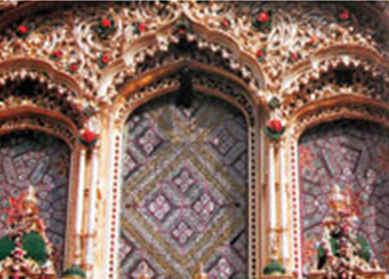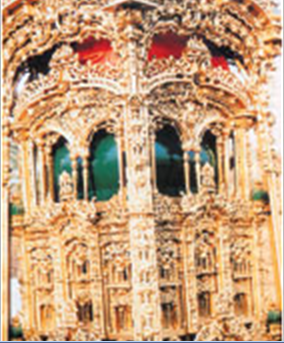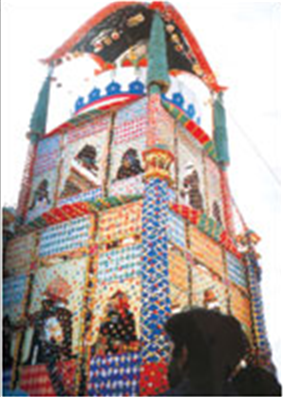Chiniot
This is a collection of articles archived for the excellence of their content. Readers will be able to edit existing articles and post new articles directly |
Chiniot
September 2, 2007
EXCERPT: Art inspired by mourning
The work brings to light the exuberant beauty of the tazias, a neglected art form of great importance in the cultural and architectural history of South Asia.
BECAUSE of the diversity of cultures, the practices of azadari seem to be unique in the subcontinent. The taziadari (tazia rituals) is one of the most prominent features of azadari (mourning). The question arises as to how the tazia rituals evolved and developed into the practices of today. When did the rituals begin, in what form, as well as what were the particular circumstances in which they were first performed in the Indian subcontinent? According to Hollister ‘the custom of carrying these models of Hussain’s tomb is said to date from the time of Timur (d. 808 AH/1405 AD), who brought such a miniature tomb back from Karbala, later called the tazia.’ Scholars agree on the origin of the tazia rituals in India, but differ on whether Timur had the zarih (the miniature model) built on order, or had it brought from Karbala. Hollister does not mention the exact date when Timur started the rituals, but Shahid Naqvi, a poet and an advocate by profession, stated in his book entitled Azadari that ‘Timur set out the tradition of taziadari in 1400 AD/803 AH’ However, according to the autobiography of Timur (translated by Marcel Breaven), ‘it was the month of Muharram (801 AH/1398 AD), when Timur finally attacked the fort of Meerath at Delhi in India.’ Shahid Naqvi define the purpose of performing tazia rituals as: ‘some of the Shiite soldiers of Timur’s army requested him to allow them to go on pilgrimage to Karbala when the war was on’ which was impossible at that time. Ultimately he found the solution to the problem and ordered the building of a zarih, a miniature model of Hussain’s mausoleum. Later, tazias of monumental proportions (as in Chiniot and Jhang) evolved from this miniature model of the tomb of Hussain at Karbala. The form of the tazia varies in different cultures of the subcontinent itself as well as in different countries.
Later the tradition of taziadari was established in Indian subcontinent the three-dimensional model of the Imam’s mausoleum known as the ‘tazia’ today; whereas, in Iran tazia is a theatrical performance or passion play, also known as ‘ta’ziya’. The ‘ta’ziya play’ in Iran resembles theatrical performances of Dasahra (Hindu festival). The most famous ta’ziya theatre was Takiyah Dawalat, the Royal Theatre in Tehran, built in the 1870s by NasirDin Shah. The performances of the passion play start from the first of Muharram and last till the 10th day. The performance progresses from day to day. Each day depicts different events of the tragedy and is performed in the names of different martyrs of Karbala. This theatre is circular in form. The shape of the central stage can vary from round to rectangular. The stage is covered with sand and the stage decor in the ta’ziya is minimal, as the setting is meant to evoke the desolate, bleak desert of Karbala. The few props are symbolic: for example, a basin of water represents the Euphrates River; the branch of a tree stands for a grove of palms. The heroes dress predominately in green; the villains wear red. Green symbolises paradise and the family of the Prophet (peace be upon him) and thus Islam; red symbolises bloodshed, cruelty and oppression. Male actors play the role of women and are dressed in baggy black garments covering them from head to toe, and their faces are veiled. When a protagonist drapes a white sheet of cloth over his shoulders, which represents a burial shroud, it indicates that he is prepared to give up his life and will be killed shortly.
In Baghdad (Iraq) the most important procession of azadari on the third day after the martyrdom of the Imam Hussain involves walking barefoot towards Karbala. About 100,000 men, women and children reach Karbala in the afternoon and start weeping and wailing. Some of them beat their heads and breasts, then enter the mausoleum and circumambulate the shrine. This tradition of azadari is more than three centuries old. Muharram commemorations at Baghdad are performed like the performances of Hajj at Mecca. Circling of the shrine of the Imam is similar to the circling of the Kaabah (a focal point of all the Muslims of the world). Walking by the peoples of Nineveh and Khazria (outskirts of Karbala) towards the shrine of the Imam is similar to the walking bare foot by Hajis (pilgrims to Mecca) from Safa to Marwa. In this way the Iraqi tradition of azadari or performances of Muharram rituals is symbolic of the event of Karbala.
In Indonesia commemorations start from the first day of Muharram by carrying clay from the river, symbolic of the clay on which the blood of the Imam flowed. On the ninth day of Muharram people go in the form of a procession along with tabal (drum) and tasha (semidrum), to the place where the clay was saved and cover it with branches of walnut trees. On the 10th day of Muharram the procession proceeds along with a taboot (replica of Imam’s bier), which is carried by a child wearing yellow. The taboot is taken from door to door and the devotees make a punjah (model of a hand) of wood, covering it with cloth or leaves and flowers are put on it, which identify the form of the alam (battle of Karbala). On the last day of commemorations devotees proceed in a procession and all taboots are thrown into canal or river on the evening of the 12th of Muharram, which is the second day after the death of the Imam. This mode of commemorations reflect Hindu and Buddhist influences, as the throwing of taboot into the canal or river is not only similar to the ritual of tazia thanda karna performed among both Sunni and Shiite communities, but also akin to the Hindus submerging of a deity in the water at the end of rituals. The use of yellow is reminiscent of the Buddhist monks or Bhikshu.
The Yawm-e-Asad or the Day of the Lion performed at Ladakh (India) are originally summertime commemorations as a supplement Muharram. The Yawm is the hottest day of the summer season in Ladakh and refers to the heat on the day of Ashura. Similarly in the Punjab, supplementary Muharram commemorations are performed on the 18th of Jeth/June (second month of Bikrmi Calendar). The difference in the way of performing the rituals also reflect how geographic and climatic conditions affect Muharram rituals. This discussion also depicts how the form of tazia/Muharram rituals varies from country to country or culture to culture. As far as the three dimensional form of the tazia is concerned, it belongs to the Indian subcontinent only. Even within the geographical boundaries of Pakistan, for example the form of tazias varies in Chiniot, Jhang and Hyderabad.
In Chiniot we find two forms of the tazia; one form closely resembles the form of Hindu temples; these are the nine famous monumental tazias, which belong to the local residents of the city. However the 10th, zarih of Muhallah Garha resembles the tomb architecture of Muslim Sufis. Probably the zarih of Muhallah Garha is the earlier form of the tazia that had become popular among the Hindu devotees of the Imam. It is thought that when the ‘local Hindus started to perform Muharram rituals along with the Muslims, as a result, both Hindus and Muslims exaggerated the form of zarih into immense tazias.’
The form of zarih of Muhallah Garha is different from the form of the nine tazias of Chiniot because this Muhallah or quarter of the city is the center of the muhajir (immigrant) families SadatBarsat (Syed families who migrated from Barsat village in district of Karnal, India) to Pakistan and settled in Chiniot in 1947. All of them belong to the Shiite faith and commemorate Muharram according to the traditions of Barsat. The tazia artist Mistry Muhammad Ghaus crafted the model of the zarih in 1967. Regarding the great difference in size and form of the zarih and the nine tazias, the question arises why the Sadat community preferred the small-sized zarih to the largetazia. Zia Haider, one of the members the Sadat at Chiniot, informed me that the model of the zarih was made on the demand of the Sadat community according to the design given by Syed Jafer Ali, an other member of Syed families. Also the tradition demands a strict adherence to the early tradition of taziadari/azadari, because the followers of the particular tradition, other than its religious significance, consider it as source of their identity. So, in the case of Muhallah Garha the form and size of the zarih is traditional and similar to the one in Barsat. It also resembles the form of some of the Hyderabadi (Sindh) tazias made from paper and bamboo, the form of which is originally that of the zarih, but is popularly called tazia.
Jhang is one of the districts of the Punjab and located in the west of Chiniot. In Jhang City, there are also two forms of tazias. One of Mori wala tazia, Machian wala tazia and Syedan wala tazia which is similar to Sufi shrines. It was amazing to see that the three tazias are replicas of the darbar of Shah Kabir in Jhang City. They are larger versions of the zarih, but in the local tradition these are also known as tazias. According to Syed Ali Abbas, a tazia artist, these tazias are older than the darbar.
The second form is similar to the form of Hindu temples. There are seven tazias constructed in this form namely Gawar ka tazia, Charoian wala tazia, tazia of Syed Said Shah, Makhe ka tazia, Dabkaran wala tazia, tazia Imambara Qadeem and Qasaian wala tazia. They all are strikingly similar to the nine tazias of Chiniot in size, form and number of parts used in them. Briefly these tazias seem to be true replicas of Chinioti tazias. The only difference that I observed is that these are carved in jali (net) style on three sides while the fourth side has been carved like Chinioti tazias in order to indicate the façade of the tazia. On the other hand Chinioti tazias have identical carvings on all four sides so that it becomes very difficult for the viewer to identify the façade of the tazia.
Shah Jamal wala tazia or Asim wala tazia as it is known now, is the oldest tazia of Jhang reportedly, built by Baba Shah Jamal in the late 19th century. Shah Jamal adopted different techniques in it. It is said that initially it comprised of four storeys of which only two have survived. Amazingly there is a Hindu temple of Lal Nath at the Jhang City that has the same form as Shah Jamal wala tazia. This tazia is a big model of the temple in which the palki (palanquin) is missing, however, the chhatri (canopy) is the only feature that can distinguish the tazia from the temple that appears to be very formal. It is unfortunate that we are unable to date the construction of both the tazia and the temple. It is said that the temple was built in the second quarter of the 19th century, either before or after the creation of Shah Jamal wala tazia. In either case, the architectural features of the temple, for example, placement of dome on the top and exclusive interplay of arches reflect vivid influence of tomb architecture or Sufi shrines and Mughal architecture in India. Most intriguing parts in both the forms of the tazia and the Hindu temple is an octagonal drum at the base of the dome, which separates it from the manzils or storeys. The octagonal drum indicates the transition of the form from square to circle. In the case of the temple construction the octagonal drum is quite similar to the architectural canons but in the tazia it looks very formal that may be because of the involvement of the tazia in the construction of the edifice. This influence also reflects the reciprocal approach of both the Hindu and Muslim communities at the cultural, social and religious level that is a marvelous example of the notions of rawadari.
Excerpted with permission from
Tazias of Chiniot
By Ghulam Abbas
Tarikh Publications, Lahore
ISBN 978-969-562-032-8
75pp. Rs600






